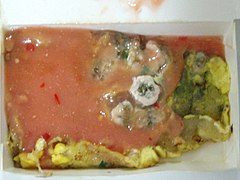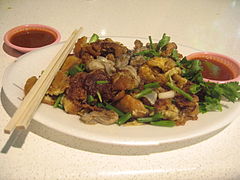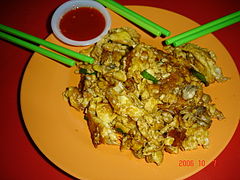 | |
| Course | Breakfast, lunch, and dinner |
|---|---|
| Place of origin | Minnan region and Chaoshan, China |
| Created by | Min Nan people (Hokkien and Teochew people) |

The oyster omelette, also known as o-a-tsian (Chinese: 蚵仔煎; Pe̍h-ōe-jī: ô-á-chian), o-chien (Chinese: 蚵煎; Pe̍h-ōe-jī: ô-chian) or orh luak (simplified Chinese: 蚝烙; traditional Chinese: 蠔烙; Peng'im: o luah), is a dish of Min Nan (Hokkien and Teochew) origin that is renowned for its savory flavor in its native Minnan region and Chaoshan, along with Taiwan and many parts of Southeast Asia, such as Philippines, Thailand, Malaysia or Singapore, due to the influence of the Hokkien and Teochew diaspora.
Ingredients
The dish consists of an omelette with a filling primarily composed of small Pacific oysters. Starch (typically sweet potato starch) is mixed into the egg batter, giving the resulting egg wrap a thicker consistency. Pork lard is often used to fry the resulting omelet. Depending on regional variations, a savory sauce may then be poured on top of the omelette for added taste.
Spicy or chili sauce mixed with lime juice is often added to provide an intense kick. Shrimp can sometimes be substituted in place of oysters; in this case, it is called shrimp omelette (蝦仁煎).
Names
In different Chinese languages, the "oyster omelette" is known by various names in different Chinese geographical regions.
| Chinese name | Pronunciations in different spoken variations | Geographical areas that use such a name |
|---|---|---|
| 蠔烙 | In Teochew: o luah In Mandarin: háo lào/luò |
In Chaoshan region and overseas communities connected to the region. |
| 蚵仔煎 | In Hokkien and Taiwanese Hokkien: ô-á-chian In Mandarin: ézǎi jiān |
Southern Fujian, Taiwan, and Philippines |
| 蚵煎 | In Hokkien: ô-chian In Mandarin: hé jiān |
Southern Fujian, Malaysia, Singapore, and Philippines |
| 牡蠣煎 | In Hokkien: bó͘-lē-chian In Mandarin: mǔlì jiān |
Most areas of mainland China |
| 海蠣煎 | In Hokkien: hái-lē-chian In Mandarin: hǎilì jiān |
Southern Fujian |
| 蠔煎 | In Cantonese: hòuh jīn In Mandarin: háo jiān |
Chaoshan, Singapore, Malaysia and Indonesia |
| 煎蠔餅 | In Cantonese: jīn hòuh béng In Hakka: Tsiên-hàu-piáng (Pha̍k-fa-sṳ) In Mandarin: jiān háo bǐng |
Hong Kong, Macau and neighboring Liangguang |
| 蠔仔餠 | In Cantonese: hòuh jái béng In Hakka: hàu-tsái-piáng (Pha̍k-fa-sṳ) In Mandarin: háo zǐ bǐng |
Hong Kong, Macau and the Pearl River Delta |
| 蠔仔煎 | In Cantonese: hòuh jái jīn In Hakka: hàu-tsái-tsiên In Mandarin: háo zǐ jiān |
Hong Kong, Macau and the Pearl River Delta |
Thailand
In Thailand known as hoi thot (Thai: หอยทอด; lit: "fried shellfish"), it was adapted to mussel omelettes (hoi malaeng phu thot, Thai: หอยแมลงภู่ทอด), though the original oyster version (hot nang rom thot, Thai: หอยนางรมทอด) also popular but more expensive. In Bangkok, notable areas for oyster omelettes include Talat Wang Lang near Siriraj Hospital and Wang Lang (Siriraj) Pier in Bangkok Noi where there are two restaurants, Yaowarat neighborhood, where there is one Michelin-Bib Gourmand restaurant with Charoen Krung neighborhood in Bang Rak, among others. In 2017, the World Street Food Congress announced that oyster omelette is one of the three most notable street foods among the street foods of Thailand.
Gallery
See also
- Night markets in Taiwan
- Hangtown fry
- Pajeon
- List of Chinese dishes
- List of egg dishes
- List of seafood dishes
References
- Hiufu Wong, Maggie (24 July 2015). "40 of the best Taiwanese foods and drinks". edition.cnn.com. CNN. Retrieved 8 April 2020.
- "หอยทอดโฮมเมด กรอบนอกนุ่มใน ความอร่อยที่ทำเองได้". Kapook (in Thai). 2013-11-26.
- "(ชมคลิป) ท้าพิสูจน์!! หอยใหญ่ไข่นุ่มร้านเจ๊อ้วน หอยใหญ่กระทะร้อน!". Khao Sod (in Thai). 2016-07-19.
- "ตี๋ใหญ่หอยทอด หอยทอดเจ้าอร่อยย่านท่าเรือศิริราช". Sanook (in Thai). 2012-01-05.
- "Nai Mong Hoi Thod". Michelin Guide. Archived from the original on 2018-08-06. Retrieved 2018-03-22.
- ""หอยทอดเท็กซัส" ทั้งสดทั้งหวาน ตำนานหอยทอดแห่งเยาวราช". Manager Daily (in Thai). 2013-02-10. Archived from the original on 2018-03-23. Retrieved 2018-03-22.
- ""ทิพ หอยทอดภูเขาไฟ" หอยใหญ่ หอยสด รสอร่อย". Manager Daily (in Thai). 2014-01-26. Archived from the original on 2014-07-29. Retrieved 2018-03-22.
- "กุ้งทอด....แทนหอยทอด". Bloggang (in Thai). 2008-04-06.
- "อร่อยระดับโลก! พี่ไทยติด 1 ใน 3 สตรีทฟู้ด 'หอยทอด' ต่างชาติบอก Yummy!". Thai Rath (in Thai). 2017-03-20.
| Oysters | |||||||
|---|---|---|---|---|---|---|---|
| Types |
| ||||||
| Industry |
| ||||||
| Culture |
| ||||||
| Fujian cuisine | |
|---|---|
| Articles | |||||||
|---|---|---|---|---|---|---|---|
| Dishes |
| ||||||
| Snacks and desserts | |||||||
| Drinks | |||||||
| Dishes and meals |  | |
|---|---|---|
| Xiaochi |
| |
| Snacks and desserts | ||
| Beverages | ||
| Ingredients | ||
| Chefs | ||
| Miscellaneous | ||
| Teochew cuisine | |
|---|---|
| Chinese cuisine |
| Individual dishes | |
|---|---|
| Shared dishes | |
| Isan dishes | |
| Northern Thai dishes | |
| Southern Thai dishes | |
| Snacks |
|
| Desserts |
|
| Miscellaneous |
|
| Beverages | |
| See also | |
| Omelettes | |
|---|---|
| Types |
|
| Tools | |







